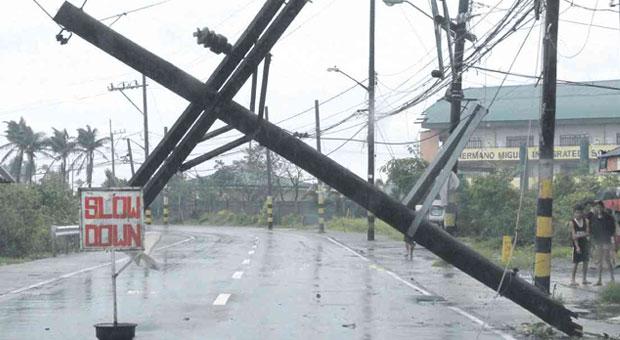
An electric post is toppled at the height of Typhoon “Glenda” (international name: Rammasun) in Noveleta, Cavite province. The typhoon led to power outages affecting a total of 13.5 million people in Luzon, including Metro Manila, and the Visayas. EDWIN BACASMAS/INQUIRER FILE PHOTO
Typhoon “Glenda” likely shaved at least P7.8 billion to as much as P10 billion off the country’s third-quarter economic output a day in terms of property damage as well as business and consumption disruptions, an economist from Citigroup estimated.
In a research note dated July 17, Citi economist for the Philippines Jun Trinidad said the wrath of Typhoon Glenda (international name: Rammasun) could translate to a potential loss of 0.2 percent of real gross domestic product (GDP) a day from power outage and other disruptions.
Citi assumed “no power, no output” and likewise factored in disruptions and consumption slowdown arising from Typhoon Glenda. However, the research noted that slower fiscal spending could cut GDP output much more than typhoon disasters.
Although there were not so much rains and flood, Trinidad said strong winds of about 120 kilometers an hour had brought down transmissions lines, caused private/public property damage and resulted in transport/distribution bottlenecks. He noted that more than 80 percent of Metro Manila—the country’s services capital—was plunged into darkness on July 16 at the height of the strongest typhoon to make landfall this year.
According to the National Disaster Risk Reduction and Management Council (NDRRMC), Typhoon Glenda destroyed P4.6-billion worth of crops and P1 billion worth of infrastructure.
Trinidad’s estimate of P7.8 billion to P10 billion in potential GDP loss a day (0.2 percent of real GDP) was based on a 2012 regional GDP data that assumed a one-day power outage affecting 70-90 percent of Metro Manila, Cavite-Laguna-Batangas-Quezon (Calabarzon) and other parts of Luzon. This estimated not only the property damage but the potential cost of business and consumer disruptions.